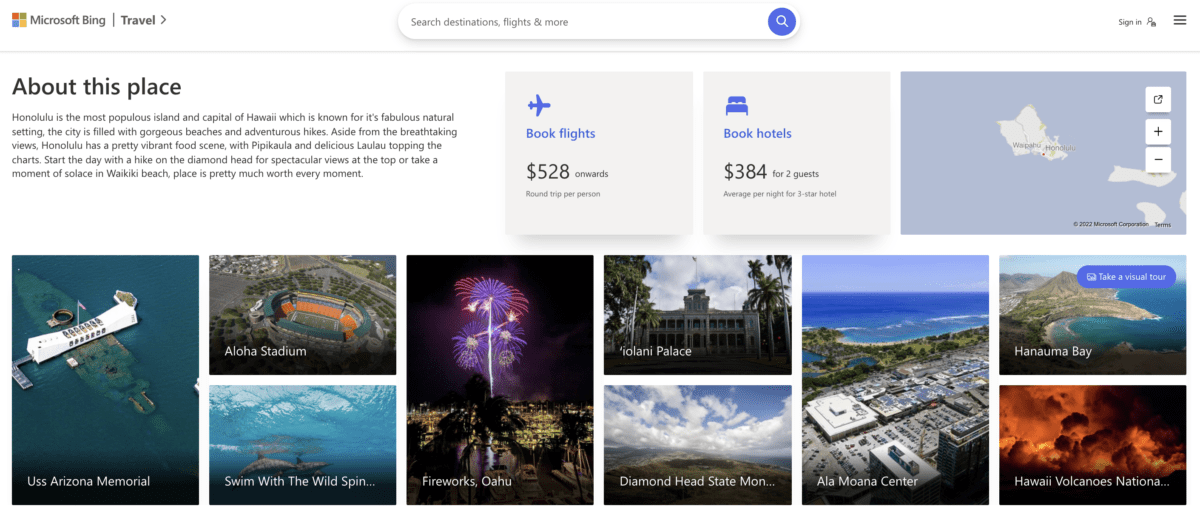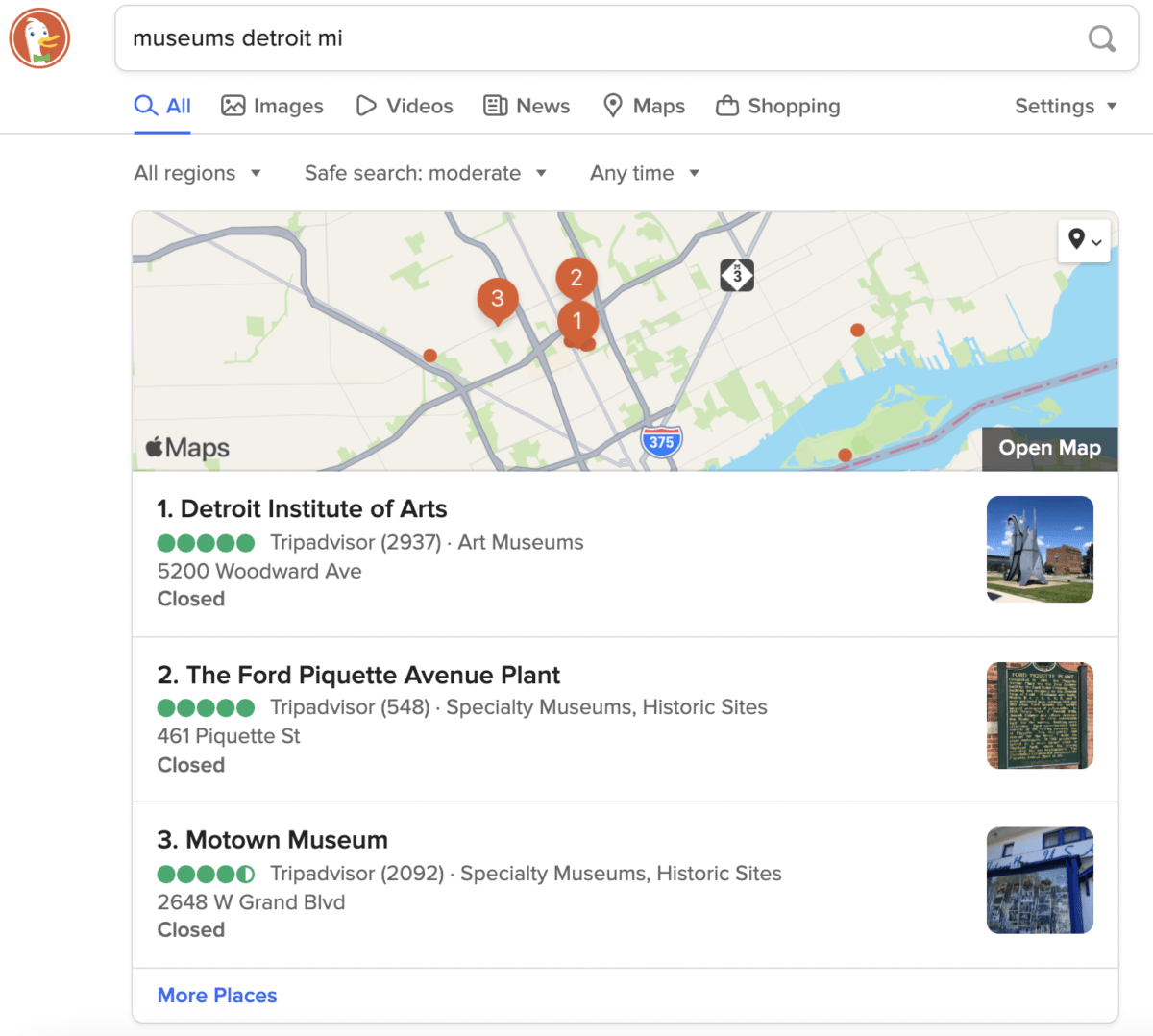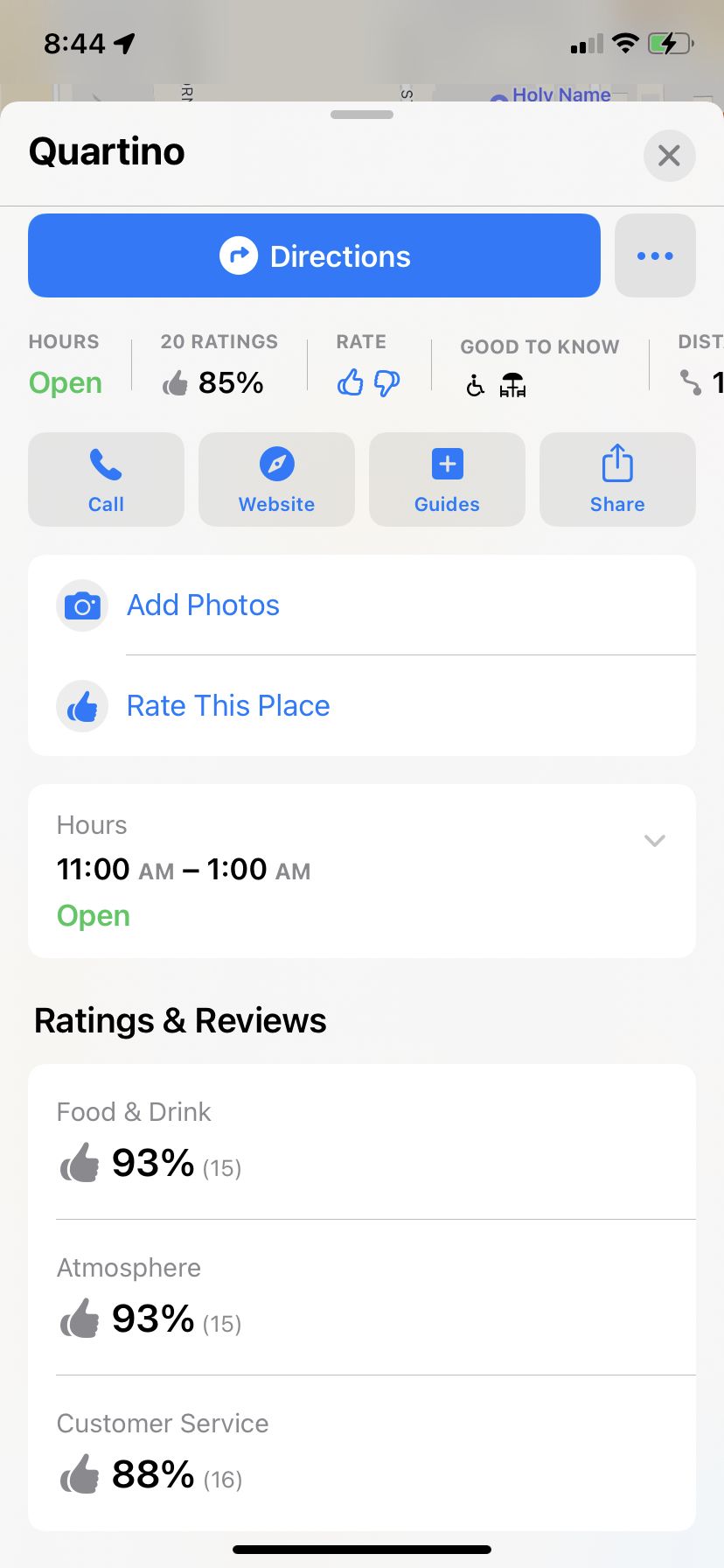In this week’s update, learn about Bing’s new Travel Guide; Google’s car inventory in local results; Apple’s embeddable maps; Apple Maps ratings in the wild; and DuckDuckGo’s growth to 100 million daily searches.
Bing Launches Travel Guide Interface
In an effort to put its own spin on travel search, Bing has launched what it calls the Travel Guide, an interface that is reminiscent of Google Travel but with a slightly different approach and set of features. Bing – which, incidentally, rebranded itself as Microsoft Bing in late 2020, in case you missed it – makes use of a more discovery-oriented and image-rich approach to travel search in its new guide, with prompts to explore things to do and places to go at your chosen destination. Searching for Honolulu brings up flight and hotel information, local attractions, sample itineraries, and articles recommending restaurants, attractions, and the “most Instagrammed places.” There’s even a section called “Popular Souvenirs” that lists “local treasures and what you can expect to pay for them.” It’s a more editorially curated, brochure-like experience than Google Travel, which focuses more, in a Google fashion, on data-driven results like price trends for flights.
We recently covered Bing’s addition of product inventory results to local listings. That and the new Travel Guide suggest an area of increased new feature development at Bing that is worth paying attention to.

A sample of the content for Honolulu on Bing’s Travel Guide
Vicinity Update Has Major Impact on Some Verticals
Guy Tsakalakis has a new post detailing what he describes as the significant impact of the Vicinity Update on local search results for attorneys. As a reminder, Joy Hawkins coined the name of this most recent local search algorithm update, which rolled out in late November and early December of 2021. The chosen name is derived from her observation that vicinity to the point of search was being weighted more heavily by Google after the update, causing listings that had previously ranked for a broad geographic area – especially those with keyword-heavy business names – to lose rankings.
Tsakalakis confirms that according to his observations, the update ramped up the importance of proximity and dialed back the significance of keywords in business names. He points to some other findings as well in which it’s more difficult to see a pattern, and agrees with Hawkins and others that the update had a bigger impact on local results than we’ve seen in some time.
Google Showing More Cars for Sale in Local Results
Users are spotting car inventory more frequently in local results, according to a writeup in Search Engine Roundtable from Barry Schwartz. The feature was first spotted in April 2021. Google has a web page on its developer site announcing the pilot of its Cars for Sale program and specifying that car inventory data can be supplied by dealerships or authorized partners. The program supports both new and used vehicles and, compared with standard product listings, gathers a deep compendium of data about each vehicle, including custom icons for desirable features like keyless start and leather seating.
Apple Announces Embeddable Map “Snapshots”
Apple has announced a new product it is calling Apple Maps Snapshots. This is a visual map that can be embedded in any web page, displaying points of interest and surrounding map details. The embeddable maps can be enabled using a simple URL and can be used in circumstances where JavaScript is not available. Users specify a point of interest upon which the map is to be centered, as well as parameters for light or dark mode and standard, satellite, or hybrid display format. Other options include whether or not to display nearby points of interest, as well as certain overlays like a dashed line that can be configured using geographical coordinates.
A version of Maps Snapshots has been employed by DuckDuckGo for some time now as part of its Apple-based local search solution, powering the local-pack-style display of business listings in DuckDuckGo search results. Maps Snapshots was first announced in 2019 and is now more broadly available.

Apple Maps Snapshot in DuckDuckGo local results
Apple Maps Ratings Showing in Some Listings
We’ve all been curious about the rollout of Apple’s native business ratings feature, which supposedly went live in the U.S. several months ago. I started a conversation on Twitter with two noted Apple Maps experts, Mike Blumenthal and Andrew Shotland, to see if either of them had seen live examples of Apple Maps ratings in business listings. Blumenthal shared that during a road trip in December when he used Apple Maps exclusively, he was able to see a few examples of Apple Maps ratings, estimating that they appeared in about 1 out of 40 listings. Shotland weighed in as well with an example of a search in Pleasanton, CA that showed one Apple Maps rated business in a list of 22 results. I was finally able to find two examples of my own, as well. Inspired by a business Blumenthal found in Chicaco that had ratings from 9 users, I conducted several restaurant searches – for Mexican food, steakhouses, Thai food, pizza, and Italian food – amassing 245 results in total, for a rate of only about 1 in 123.
Though we surmised that Apple might be displaying ratings when Yelp had few or no reviews, further research showed this wasn’t the case, nor does it seem Apple switches to its own ratings whenever it has content to show. The pattern is elusive, but Apple is clearly rolling out the feature, if very slowly. All of our examples were restaurants. Per our examples, Apple displays the overall positive rating percentage in list results, whereas in the business profile it shows how many have rated the business as well as ratings for subtopics like food and drink, atmosphere, and customer service.

An example of the rare natively rated business in Apple Maps
DuckDuckGo Hits 100 Million Searches per Day
Privacy-oriented search engine providers Brave and DuckDuckGo have experienced massive growth in adoption over the past year, with Brave reporting 50 million monthly active users for its products in December and DuckDuckGo reporting 46% growth in 2021. The latter company claims it now typically sees more than 100 million searches per day, claiming that 9% of U.S. survey respondents say they are regular users of DuckDuckGo. Greg Sterling predicts that in 2022, DuckDuckGo will overtake Yahoo to become the number two mobile search engine in the U.S. (Bing is number two for desktop.)
Damian Rollison
Subscribe to Local Memo!
Signup to receive Local memo updates and the latest on localized marketing, delivered weekly to your inbox.